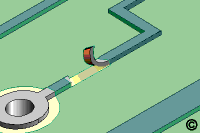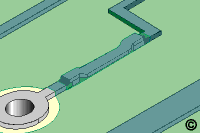No. 4.2.2
Conductor Repair, Foil Jumper, Film Adhesive Method
OUTLINE
This method is used to replace damaged or missing circuits on the circuit board
surface.
CAUTION
It is essential that the board surface be extremely smooth and flat. If the base
board is damaged see appropriate procedure.
TOOLS & MATERIALS
Bonding Iron
Bonding Tips
Bonding System
Buffer
Circuit Frame, Conductors
Cleaner
Epoxy
Flux, Liquid
Knife
Microscope
Oven
Scraper
Solder
Soldering Iron
Surgical Knife
Tape, Kapton
Tweezers
Wipes
PROCEDURE
- Clean the area.
- Remove the damaged section of circuit using the knife. The damaged circuit
should be trimmed back to a point where the circuit still has a good bond to the
PC board surface.
- Use the knife and scrape off any epoxy residue, contamination or burned
material from the board surface
- Scrape off any solder mask or coating from the connecting circuit. (See
Figure 1).
- Clean the area.
- Apply a small amount of liquid flux to the connection area on the board
surface and tin with solder. Clean the area. The length of the overlap solder
connection should be a minimum of 2 times the circuit width.
- Select a replacement circuit with film adhesive backing that most closely
matches the size of the conductor to be replaced. If a special size or shape is
needed it can be custom fabricated. (See Figure 2).
NOTE
New conductors are fabricated from copper foil. The foil is plated on the top
side with solder and an epoxy bonding film is applied to the bottom side.
- Before trimming out the new conductor carefully scrape off the adhesive
epoxy film from the solder joint connection area on the back of the new
conductor. (See Figure 3).
CAUTION
Scrape off the epoxy backing only from the joint connection area. When handling
the new conductor avoid touching the epoxy backing with your fingers or other
materials that may contaminate the surface and reduce the bond strength.
- Cut out and trim the new conductor. Cut out from the plated side. Cut the
length to provide the maximum allowable circuit overlap for soldering. Minimum 2
times the circuit width. (See Figure 4).
NOTE
If the configuration permits, the overlap solder joint connection should be a
minimum of 3.00 mm (0.125") from the related termination. This gap will
minimize the possibility of simultaneous reflow during soldering operations.
Refer to 7.1 Soldering Basics.
- Place a piece of Kapton tape over the top surface of the new conductor.
Place the new conductor into position on the circuit board surface using Kapton tape
to help in alignment. Leave the Kapton tape in place during the bonding cycle.
(See Figure 5).
- Select a bonding tip with a shape to match the shape of the new conductor.
NOTE
The bonding tip should be as small as possible but should completely cover the
entire width of the new conductor.
- Position the circuit board so that it is flat and stable. Gently place the hot
bonding tip onto the Kapton tape covering the new circuit. Apply pressure as
recommended in the manual of the repair system or repair kit for 5 seconds to
tack the circuit in place. Carefully peel off the tape. (See Figure 6).
-
Gently place the bonding tip directly onto the new circuit. Apply pressure as
recommended in the manual of the repair system or repair kit for an additional
30 seconds to fully bond the new circuit. The new circuit is fully cured. Carefully
clean the area and inspect the new circuit for proper alignment.
- Apply a small amount of liquid flux to the lap solder joint connection area
and solder the circuit foil jumper from the new conductor to the circuit on the
PC board surface. Use minimal flux and solder to ensure a reliable connection.
Kapton tape may be placed over the top of the new conductor to prevent excess
solder overflow.
- Mix epoxy and coat the lap solder joint connections. Cure the epoxy per
Procedure 2.7 Epoxy Mixing and Handling.
CAUTION
Some components may be sensitive to high temperature.
- Apply surface coating to match prior coating as required.
EVALUATION
- Visual examination.
- Measurement of new pad width and spacing.
- Electrical continuity measurement
|
|
|
Solutions Across the Board
TM
|
|
|
|
Product Class: R/F/C
Skill Level: Advanced
Conformance Level: High
Revision: E
Revision Date: Mar 28, 2001
Repair Service Charge

Damaged Conductor

Figure 1: Remove solder mask from the connecting circuit.

Figure 2: Sample frame or replacement conductors with dry film adhesive backing.

Figure 3: Scrape off epoxy bonding film from solder joint connection area on
back of new conductor.

Figure 4: Cut out the new circuit. Cut from the plated side.

Figure 5: Place the new conductor in place using Kapton tape.

Figure 6: Bonding System used to thermally bond dry film adhesive backed
replacement conductors.

Figure 7: Completed repair.
|
Tricks of the Trade
This is an excellent method to repair a damaged conductor,
however we generally use procedure 4.2.1
Conductor Repair, Foil Jumper, Epoxy Method. This other method uses
replacement conductors that are easier to form if the missing conductor has any
bends or turns.
|
|
|
